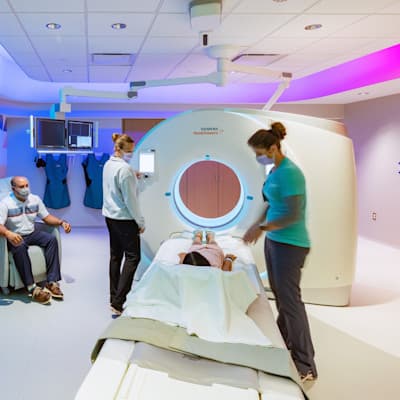Understanding Your Child’s Nuclear Medicine Scan
Discover what to expect during your child’s nuclear medicine scan, how to prepare and how this procedure helps diagnose health conditions.

Thanks to medical imaging, physicians have had the ability to see inside the body using tests such as X-rays, computerized tomography (CT) and magnetic resonance imaging (MRI). Sometimes, they need to see more functional data than these are able to provide, which is when nuclear medicine may be used.
Nuclear medicine allows your child’s physician to see all the way down to the molecules in their body, which makes it possible to identify diseases, injuries and infections at a very early stage. That way, they can be evaluated and treated as soon as possible.
Nuclear medicine uses a small amount of a radioactive tracer and a special camera to see the structures inside your child’s body and how they function. Before the scan, your child will receive a small amount of radioactive material, which may be injected, swallowed or inhaled. Then, a camera takes images of the inside of your child’s body.
There are different types of nuclear medicine scans, including:
A Mag 3 scan, which helps determine how well your child’s kidneys are functioning
A HIDA scan, which helps determine how well your child’s gallbladder is functioning
A Gastric Empty scan, which helps determine how well your child’s stomach is functioning
A bone scan, which helps track several types of bone diseases
A Meckel’s scan, which helps detect abnormally-located gastric mucosa (mucous membrane layer of the stomach)
A DMSA scan, which helps evaluate the function, size, shape and position of your child’s kidneys and detects scarring caused by frequent infections
A pulmonary perfusion scan, which helps evaluate blood flow to your child’s lungs
A thyroid uptake and scan, which helps evaluate the size, location and overall functional level of your child’s thyroid gland
What Happens During a Nuclear Medicine Scan?
Knowing what to expect during a nuclear medicine scan can help prepare you and your child for the procedure. Each type of scan is different, but there are some similarities among all of them.
Before the scan, a child life specialist will meet with you and your child to help explain the procedure so your child can understand it, show you pictures of the camera and room the procedure will occur in, and help your child develop a positive coping plan.
For some nuclear scans, your child may need an IV inserted before. Scans that may require an IV include:
Mag 3 scan
HIDA scan
Bone scan
Meckel’s scan
DMSA scan
Pulmonary perfusion
If your child needs an IV, the nurse will place it before the exam. The steps of IV placement are:
Your child’s nurse will place a tourniquet (rubber band) on their arm, which will give your child’s arm a tight squeeze or hug
The nurse will clean their skin with wet soap
Your child will feel an initial poke to get the needle and straw in the right spot
Once the straw is in the right spot, the nurse will remove the needle and only the straw will be left in your child’s vein
The nurse will cover the IV straw with tape in order to keep it in the right spot during your child’s scan
Once the IV is in place (if applicable), you and your child will be taken to the nuclear medicine room where your child may be asked to change into a hospital gown and lie down on the bed. Two adults will be allowed to accompany your child to the exam room. If you’re pregnant, you will be unable to accompany your child due to the risks associated with radiation. If you’re planning on bringing other children with you, one adult will need to stay in the waiting area with them.
During all scans, your child will need to hold their body still in order to get clear pictures. Seatbelts are available if your child needs assistance in holding their body still. During imaging, your child can watch TV or pick a movie to watch.
How Can You Prepare and Support Your Child With Their Nuclear Medicine Scan?
It’s normal for your child to feel anxious about a nuclear medicine scan. However, there are ways you can help them feel safe and comfortable, such as:
Using developmentally appropriate words to explain to your child what will happen.
Brining a comforting item — such as a blanket or stuffed animal — for your child to have with them during their scan.
Asking your physician, nurse, or child life specialist what pain management options are available for your child.
During the procedure, providing support by holding their hand, validating their feelings, and engaging your child in distractions, such as looking at a book, playing a game or watching a movie.
Participating in One Voice, an initiative to promote a calming environment by limiting the number of voices in the room so your child knows who to focus on, such as a parent or procedural staff professional.
Practicing deep breathing at home by pretending to blow out birthday candles or blowing bubbles.
Displaying a calm demeanor.
Meet with one of our Child Life specialists — experts who can explain the procedure in child-friendly terms and help you and your child understand what will happen at every stage of the scan
Questions?
Contact the Radiology Child Life specialist at 402.955.4042 or the Radiology Department at 402.955.5602.
